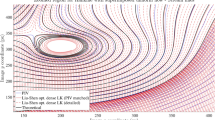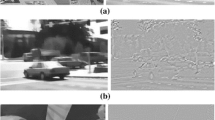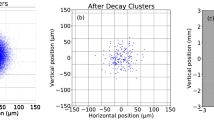Abstract
A new learning-based approach for determining fluid flow velocities and dominant motion patterns from particle images is proposed. It is a local parametric technique based on linear spatio-temporal models, which have previously been obtained by methods of unsupervised learning using proper orthogonal decomposition (POD). The learned motion models, embodied by the first POD modes, capture information about complex relations between neighboring flow vectors in spatio-temporal motion patterns. These motion models ensure the solution of the flow problem to be restricted to the orthogonal space spanned by the POD modes. Additional information about local, dominant flow structures can be gained by the POD modes and related parameters. The method can easily be tuned for different flow applications by choice of training data and, thus, is universally applicable. Beyond its simple implementation, the approach is very efficient, accurate and easily adaptable to all types of flow situations. It is an extension of the optical flow technique proposed by Lucas and Kandade (Proceedings of the 1981 DARPA image understanding workshop, pp 121–130, 1981) in their seminal paper. As such, it can also be applied as a postprocessing step to particle image velocimetry (PIV) measurements and improves the results for all conditions analyzed. The approach was tested on synthetic and real image sequences. For typical use cases of optical flow, such as small image displacements, it was more accurate compared to PIV and all other optical flow techniques tested.













Similar content being viewed by others
References
Baker S, Scharstein D, Lewis J, Roth S, Black M, Szeliski R (2011) A database and evaluation methodology for optical flow. Int J Comput Vision 92(1):1–31. doi:10.1007/s11263-010-0390-2
Bangerth W, Hartmann R, Kanschat G (2007) deal.II—a general purpose object oriented finite element library. ACM Trans Math Softw 33:24/1–24/27
Barron J, Fleet D, Beauchemin S (1994) Performance of optical flow techniques. IJCV 12(1):43–77
Berkooz G, Holmes P, Lumley JL (1993) The proper orthogonal decomposition in the analysis of turbulent flows. Annu Rev Fluid Mech 25:539–575
Bigün J, Granlund GH, Wiklund J (1991) Multidimensional orientation estimation with application to texture analysis and optical flow. IEEE J Pattern Anal Mach Intell 13(8):775–790
Black M, Yacoob Y, Jepson A, Fleet D (1997) Learning parameterized models of image motion. In: Proceedings of the international conference on computer vision and pattern recognition
Black MJ, Anandan P (1996) The robust estimation of multiple motions: parametric and piecewise-smooth flow fields. Comput Vis Image Underst 63:75–104
Black MJ, Jepson A (1996) Estimating optical flow in segmented images using variable-order parametric models with local deformations. PAMI 18(10):972–986
Bruhn A (2006) Variational optic flow computation—accurate modelling and efficient numerics. PhD thesis, Universität des Saarlandes
Bruhn A, Weickert J, Schnörr C (2005) Lucas/kanade meets horn/schunck: combining local and global optic flow methods. Int J Comput Vision 61(3):211–231
Carlier J (2005) 2d Turbulence sequence. Provided by CEMAGREV within the European project ’Fluid Image Analysis and Description’. http://fluid.irisa.fr/
Corpetti T, Mémin É, Pérez P (2002) Dense estimation of fluid flows. IEEE Trans Pattern Anal Mach Intell 24:365–380
Garbe C, Jähne B (2001) Reliable estimates of the sea surface heat flux from image sequences. In: Radig B (ed) Mustererkennung 2001. Springer, New York, vol LNCS 2191, pp 194–201. doi:10.1007/3-540-45404-7_26
Garbe C, Spies H, Jähne B (2003) Estimation of surface flow and net heat flux from infrared image sequences. J Math Imaging Vis 19(3):159–174. doi:10.1023/A:1026233919766
Garbe C, Schimpf U, Jähne B (2004) A surface renewal model to analyze infrared image sequences of the ocean surface for the study of air-sea heat and gas exchange. J Geophys Res 109:C08S15. doi:10.1029/2003JC001802
Haussecker H, Spies H (1999) Handbook of computer vision and applications. Academic Press, New York, chap 13, pp 309–396
Haussecker HW, Fleet DJ (2001) Computing optical flow with physical models of brightness variation. IEEE Trans Pattern Anal Mach Intell 23:661–673
Heitz D, Mémin E, Schnörr C (2010) Variational fluid flow measurements from image sequences: synopsis and perspectives. Exp Fluids 48:369–393
Horn BKP, Schunck BG (1981) Determining optical flow. Artif Intell 17:185–203
LaVision (2014) Data acquisition and Visualisation (DaVis). http://www.lavision.de/de/products/davis.php. Accessed 20 May 2014
Liu C (2009) Beyond pixels: exploring new representations and applications for motion analysis. PhD thesis, Massachusetts Institute of Technology
Liu T, Shen L (2008) Fluid flow and optical flow. J Fluid Mech 614:253–291
Lucas BD, Kanade T (1981) An iterative image registration technique with an application to stereo vision (darpa). In: Proceedings of the 1981 DARPA image understanding workshop, pp 121–130
Lumley JL (1967) The structure of inhomogeneous turbulent flows. In: Atmospheric turbulence and radio wave propagation
Mémin E, Pérez P (1998) Dense estimation and object-based segmentation of the optical flow with robust techniques. IEEE Trans Image Process 7:703–719
Merzkirch W (2007) Handbook of experimental fluid mechanics. Springer, New York, chap 11, pp 857–870
Nieuwenhuis C (2009) Postprocessing and restoration of optical flows. PhD thesis, Ruprecht Karls University Heidelberg
Nieuwenhuis C, Kondermann D, Garbe C (2010) Complex motion models for simple optical flow estimation. Pattern Recognit (Proc DAGM) LNCS 6376:141–150
Nobach H, Tropea C, Cardier L, Bonnet JP, Delville J, Lewalle J, Farge M, Schneider K, Adrian RJ (2007) Handbook of experimental fluid mechanics. Springer, New York, chap 22, pp 1337–1398
Quénot GM (1999) Performance evaluation of an optical flow technique for particle image velocimetry. In: Euromech colloquium on image processing in applied mechanics, pp 177–180
Quénot GM, Pakleza J, Kowalewski TA (1998) Particle image velocimetry with optical flow. Exp Fluids 25:177–189
Raffel M, Willert CE, Wereley ST, Kompenhans J (2007) Particle image velocimetry: a practical guide. Springer, New York
Ruhnau P, Schnörr C (2007) Optical stokes flow estimation: an imaging-based control approach. Exp Fluids 42:61–78
Ruhnau P, Kohlberger T, Schnörr C, Nobach H (2005) Variational optical flow estimation for particle image velocimetry. Exp Fluids 38:21–32
Ruhnau P, Stahl A, Schnörr C (2007) Variational estimation of experimental fluid flows with physics-based spatio-temporal regularization. Meas Sci Tehnol 18:755–763
Scarano F, Riethmuller ML (1999) Iterative multigrid approach in piv image processing with discrete window offset. Exp Fluids 26:513–523
Scharr H (2007) Optimal filters for extended optical flow. In: Complex motion, lecture notes in computer science, Volume 3417
Staack K, Garbe C (2011) Microflow characterization using physical constraints and optimal control. In: 9th International symposium on particle image velocimetry—PIV11, pp 1–4
Stanislas M, Okamoto K, Käler CJ, Westerweel J, Scarano F (2008) Main results of the third international piv challenge. Exp Fluids 45:27–71
Strzodka R, Garbe C (2004) Real-time motion estimation and visualization on graphics cards. In: Proceedings IEEE visualization 2004, pp 545–552. doi:10.1109/VISUAL.2004.88
Weier T, Albrecht T, Gerbeth G, Wittwer S, Metzkes H, Stiller J (2011) The electromagnetically forced flow over a backward-facing step. In: TSFP7 Ottawa
Yacoob Y, Davis L (1998) Learned temporal models of image motion. In: International conference on computer vision
Yuan J, Schnörr C, Mémin É (2007) Discrete orthogonal decomposition and variational fluid flow estimation. J Math Imaging Vis 28:67–80
Acknowledgments
We thank the two anonymous reviewers who helped to significantly improve the quality of this manuscript through their comments. Also, financial support by the DFG Research Training Group GRK1114 “Optical Techniques for Measurement of Interfacial Transport Phenomena” is gratefully acknowledged.
Author information
Authors and Affiliations
Corresponding author
Rights and permissions
About this article
Cite this article
Stapf, J., Garbe, C.S. A learning-based approach for highly accurate measurements of turbulent fluid flows. Exp Fluids 55, 1799 (2014). https://doi.org/10.1007/s00348-014-1799-0
Received:
Revised:
Accepted:
Published:
DOI: https://doi.org/10.1007/s00348-014-1799-0




